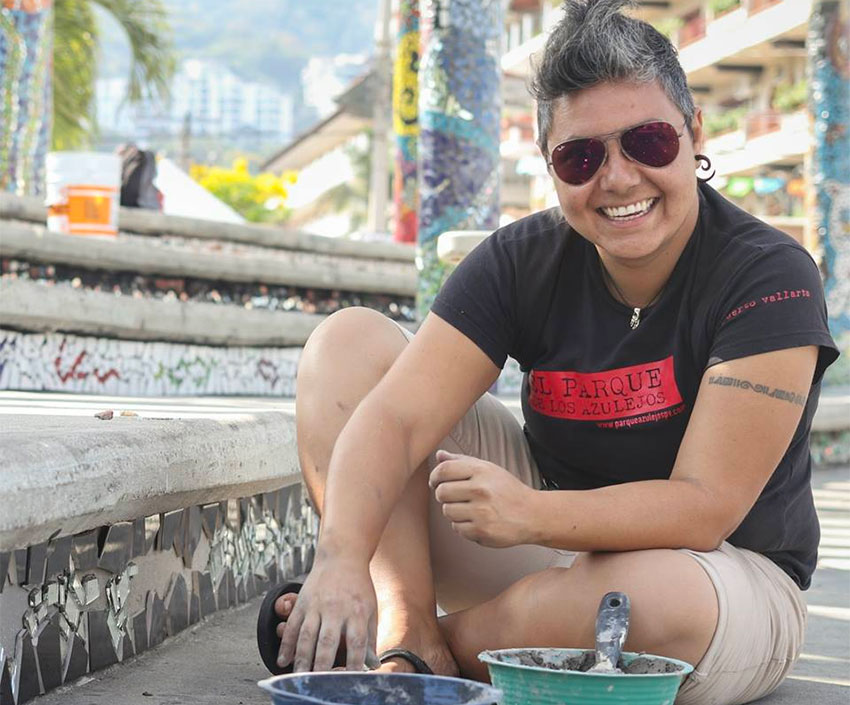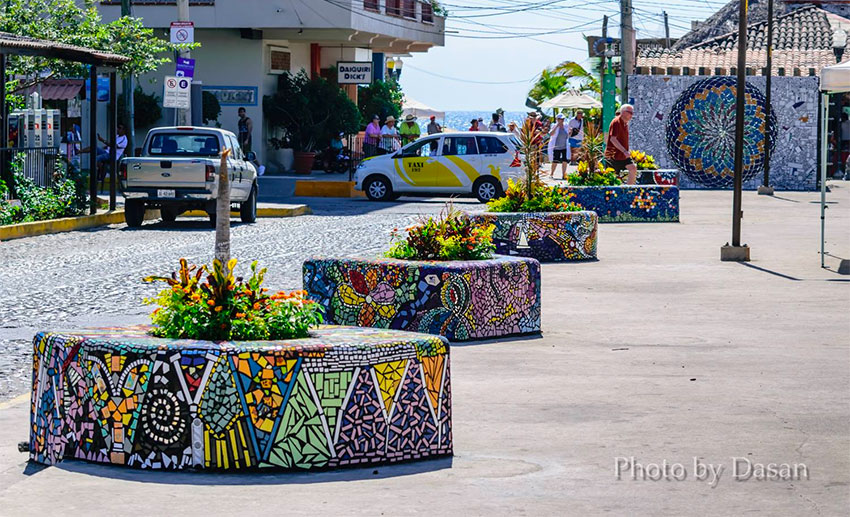Mexico is no stranger to tile, but it’s been considered more of a utilitarian medium than an artistic one. Mosaics or trencadís (work with broken tiles), though fairly common in southern Europe, are few and far between here.
But Natasha Moraga is out to change that. The largely self-taught mosaic artist has made her mark covering the walls and public spaces of the Pacific Coast resort city of Puerto Vallarta tile by tile, often in collaboration with the local and foreign communities.
Born in La Mirada, California, to a Chilean father and a Mexican mother, Moraga was 8 years old when her parents chose to move the family to Mexico — eventually to Puerto Vallarta. Although she had some difficulty adjusting initially, Moraga doesn’t regret her parents’ decision.
Moraga’s American background shows in her fierce sense of independence. After a tumultuous period of rebellion, at age 15 she moved out. She’s taken care of herself ever since, living in various parts of Mexico and having several relationships. She moved to Germany with a girlfriend but soon moved on, finding the culture and people there to be cold. During a trip to Barcelona she discovered the trencadís work of Antoni Gaudí.
Despite an inability to draw, Moraga always felt the need to to work at an artistic endeavor. She experimented with various forms of expression but was drawn to tile, in no small part due to its highly tactile nature.

On returning to Vallarta she told a friend about what she had seen in Barcelona. The friend immediately offered to cover her travel and lodging if she could get a scholarship to train with award-winning mosaic artist Isaiah Zagar in Philadelphia. Moraga described her week there as “carrying buckets” and “watching,” but it formed the basis of her later work and organization.
Friends and family were mostly skeptical of her artistic aspirations. After the time with Zagar, her father convinced her to follow his example and open a restaurant, but after two years in that line she lost interest and shut it down.
At that point, she had only 20,000 pesos to her name and was living in an apartment in Old Town near a school wall full of unsightly graffiti. Moraga went to the city for permission to install a mosaic there, fully expecting to be turned down. Pleasantly surprised by a positive response, she went to work on it in October 2011.
“After I put up the first tile, I knew what to do.” But there was a practical issue. How could she support herself in this line of work? The answer came when a woman approached the site and offered US $100 to put her name on one of the tiles as a sponsor. Sales of such tiles paid for her materials and time. It has been a key source of financing ever since.
The school wall remains Moraga’s favorite, but she has gone on to more ambitious projects. The city proposed a mural project at the marina. Officially called Episodio 2, it is the second largest mosaic mural in Mexico. (The first is at Ciudad Universitaria in Mexico City.)
This was soon followed soon by an assignment to cover the standing letters spelling out “Puerto Vallarta” at the north entrance to the city. Municipal authorities initially opposed the idea, but support from the hotel association, which saw tourism value in the work, eventually won out.

While Moraga has done smaller projects at various local hotels and on public benches, she tends to think big … very big.
Her current project is the Parque de Azulejos, or Tile Park, located in Lázaro Cárdenas Park on the south side of the city. It was started in 2017, coinciding with the 100th anniversary of the official founding of the city.
The long-term project has become an exercise in community building with an accent on artistic expression. Tile Park brings together locals, foreign residents and even any tourists who want to contribute — and more than a few want to get their hands dirty.
Here is where Moraga’s bilingual and bicultural background comes in handy. She can work with both local bricklayers, who prepare the surfaces, and otherwise idle retirees with little to no Spanish. The project is entirely financed with private funds. Sponsorship tiles are sold through its website, which also features an old-fashioned donation box.
Calling the organization Mosayko Vallarta, she’s made a stir in the city, though few may realize she’s the person behind it all. The effect comes not only from the works themselves, but from the hundreds of people Moraga has trained “to carry buckets” through volunteer workshops. Some of the participants have contributed to the designs in Tile Park, and some have even gone on to do their own projects.
Moraga learned with U.S. materials but had to adapt to Mexican ones. Most of the works are done in local tiles, but they can also include stone, glass, mirrors and recycled materials. Most of the designs are abstract or semi-abstract, incorporating various types of symbolism. Moraga believes such symbols have an effect, whether or not onlookers recognize them.
The artist classifies what she does as urban or street art, as it is community-based, done by and for the public. She finds galleries intimidating and isn’t interested in creating works “for rich people to purchase.”
Mexico News Daily
